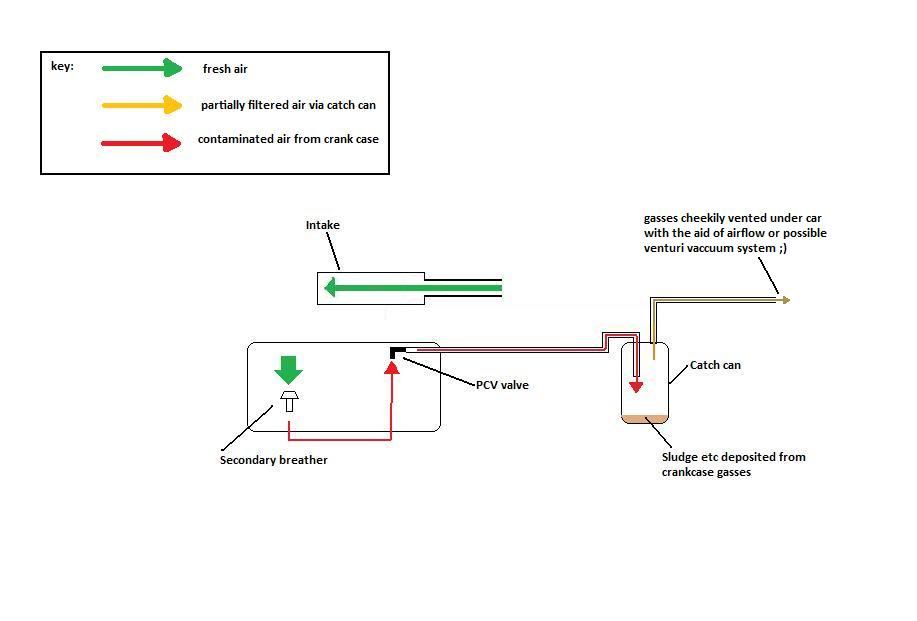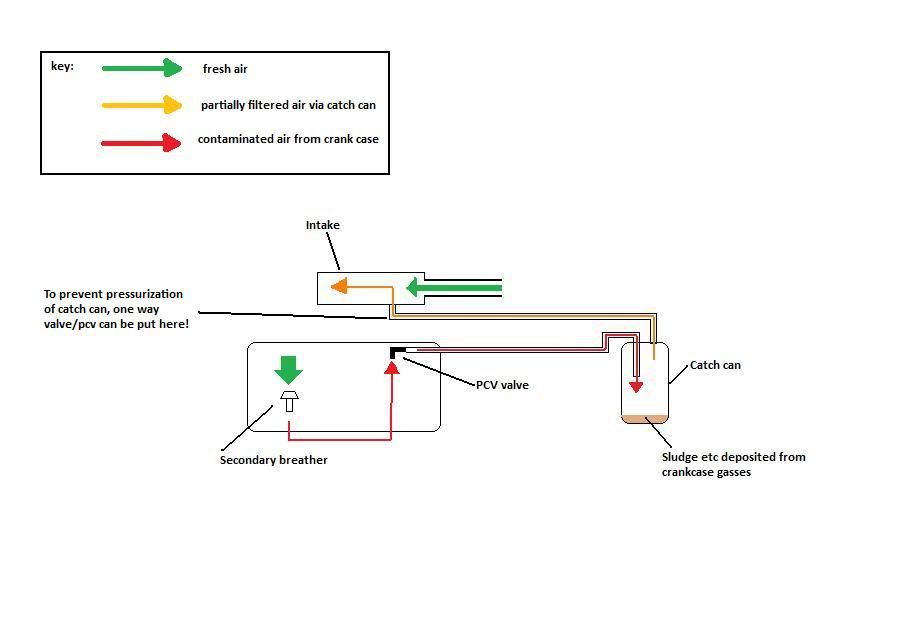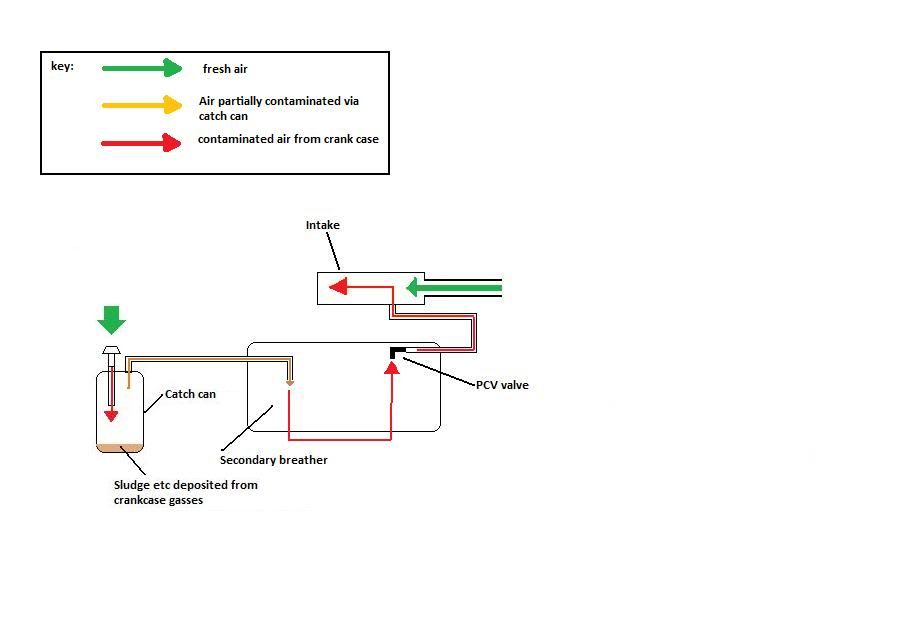Confused? read here for full explanation!!
Until 1965, most cars and small trucks had a vent, often called a road draft tube, which vented the crankcase to the atmosphere. After 1965, legislation brought forward a governmentally mandated device to be installed on all vehicles. The positive crankcase ventilation (PCV) valve is a simple system that introduces filtered fresh air into the crankcase. The PCV valve uses the engine’s vacuum to pull air through the crankcase and reintroduce it back into the intake manifold system. This sends the uncombusted hydrocarbons and nitrous oxides that blew by the rings another chance for complete combustion, and in later vehicles, to be managed by the engine’s emission control system.
http://www.machinerylubrication.com/Read/234/pcv-system
According to this the PCV valve works both ways and the standard setup would be the best as it would provide clean air in and get all that 80% unburned petrol back in to the inlet.....
http://www.autoshop101.com/forms/h63.pdf
Right it seems there's a lot of confused people on here with a lot of conflicting views haha. I'll do my best to answer some of these questions raised etc from my understanding of the whole pcv/catch can systems.
On the 4efte it seems you have two crankcase breathers:
1. the
PCV valve which is a one way valve allowing air
out of the crankcase whilst
off boost and stopping charged air from entering the crankcase via the post turbo intake when under boost.
2. the
standard breather,which as far as Im aware flows in both directions once removed from the recirc valve.
Both these breathers work together to form the PCV
SYSTEM
So to answer the question "does the PCV
valve let fresh air into the engine whilst displacing blow by gasses?" would technically be
NO. But if you were to ask "does the PCV
system (ie the two breathers working in conjunction with each other) let fresh air into the engine whilst displacing blow by gasses?" then the answer would be
YES!
You see as the PCV
valve expels gasses from the crankcase into the intake whilst the intake is in a vaccuum state (off boost), "fresh air" is brought into the crankcase via the secondary breather due to displacement (ie the intake is causing a vaccuum within the crankcase because whilst off boost the two are connected via the PCV
valve), which in turn causes air to be sucked in through the secondary breather to try and equalise the resultant pressure drop).
Whilst under boost however, the PCV
valve is closed due to pressurised air from the turbo/intake trying to enter the crankcase(remember the PCV
valve is a one way valve). In this state the secondary valve takes over the job of venting the crankcase gasses, but due to the secondary valve not having a vaccuum source and the crankcase not having another fresh air supply all it can do is equalise the crankcase pressure with atmospheric pressure therefore not taking in fresh air.
When talking about catch cans, their job primarily is to eliminate (vent to atmosphere cans) or reduce (sealed system cans) the crankcase gasses from entering the intake and causing contamination and octane issues leading to detonation.
To completely eliminate the probability of crankcase gasses entering the intake.
To do this you have to install a vent to atmosphere catch can, the best example i've seen on this thread I think would be rory's as he has tried to replicate the vaccuum system for the PCV valve
BUT there is one vital flaw to it; it has no means of a fresh air supply to the crank case, both breathers are acting as how I explained the secondary breather works whilst under boost. To correctly set it up, you only need the PCV
valve side and the 'to atmosphere under the car' pipe connected to the catch can (all other holes to the catch can blocked off), the secondary breather then needs a filter (higher flow the better) and left to suck in from the atmosphere.
The disadvantage of this system though is that it is technically illegal and lacks any major vaccuum source. Therefore your relying on air flowing under the car to suck out air from the catch can 'exhaust' so that you have a unidirectional PCV
system that draws in fresh air from the seconday breather. In an ideal situation you would connect the catch can exhaust to a small vaccuum pump to provide a constant powerful enough vaccuum to attain this. To improve the system without a vaccuum pump I would recommend experimenting with a venturi valve connected to the exhaust of the catch can that is fed via the airflow under the car, this would provide a much better vaccuum whilst at speed.
To reduce the amount of crankcase gasses entering the intake whilst staying legal and maintaining a more constant fresh air supply.
To do this all you need do is copy the previous design ie PCV
valve connected to catch can 'intake' , catch can 'exhaust' connected to (ideally use another PCV inline to the intake if this doesn't cause too much flow restriction so catch can isnt pressurised during boost) post turbo intake (part of intake where PCV
valve used to go) and then put a filter on the secondary breather (not sure of legality on turbo cars). This will make sure that while off boost the intake vaccuum will suck crankcase gasses out of the crankcase through the catch can (catching some of the shite) then back into the engine, whilst fresh air is brought through the secondary filter. Whilst under boost however, the PCV valves close (assuming you've used two), stopping pressurised air from the intake entering the catch can and crankcase, whilst the secondary breather filter is used as an exhaust to vent crankcase pressures should they exceed atmospheric pressure (this is where Im unsure of the legality of using a filter here on turbo cars as essentially it's dumping to atmosphere albeit through a filter whereas on an NA car this wouldnt happen). Disadvantages of this set up are obviously that even though you are indeed 'catching' some of the shite in the catch can, some is still innevitibly being dumped into your intake.
Hope this has helped clear things up for people, I would post up some diagrams to help explain but I cant be arsed drawing any at this hour lol. Please feel free to fire any questions at me and Ill endeavour to answer them should I see them.
Gaz



